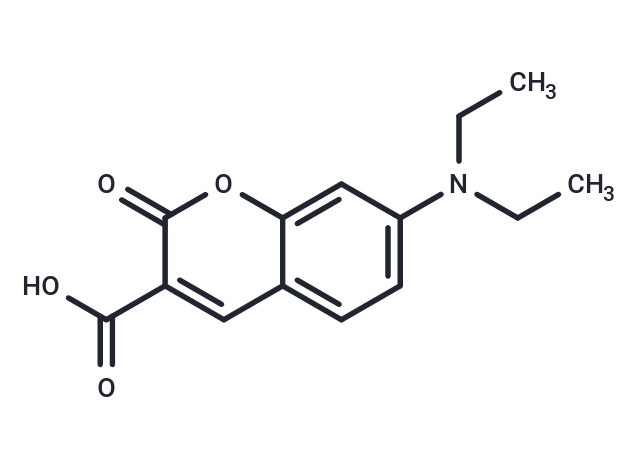 您的购物车当前为空
您的购物车当前为空
7ACC1
一键复制产品信息别名 香豆素D1421, DEAC, D 1421, Coumarin D 1421, 7-(Diethylamino)coumarin-3-carboxylic acid
7ACC1 (D 142) 抑制表达MCT1和MCT4肿瘤细胞的乳酸涌入,能选择性干扰肿瘤微环境乳酸通量。

7ACC1
一键复制产品信息7ACC1 (D 142) 抑制表达MCT1和MCT4肿瘤细胞的乳酸涌入,能选择性干扰肿瘤微环境乳酸通量。
| 规格 | 价格 | 库存 | 数量 |
|---|---|---|---|
| 100 mg | ¥ 99 | 现货 | |
| 1 mL x 10 mM (in DMSO) | ¥ 146 | 现货 |
7ACC1 相关产品
产品介绍
| 产品描述 | 7ACC1 (D 142) selectively affects a single part of the MCT symporter translocation cycle, leading to strict inhibition of lactate influx. This singular activity is associated with antitumor effects less prone to resistance and side effects. |
| 体外活性 | 7-(Diethylamino)coumarin-3-carboxylic acid对乳酸摄入的影响研究发现,在使用氧化癌细胞进行的实验中,这些细胞已知能够维持其体外乳酸作为能量燃料的摄取能力,而对于高度糖解的细胞,该化合物对乳酸排出没有影响。相应地,在表达MCT1和MCT4亚型的氧化人类宫颈癌细胞SiHa和Hela中,7-(Diethylamino)coumarin-3-carboxylic acid显著抑制了乳酸摄入和细胞增殖,而公认的MCT1/MCT2抑制剂AR-C155858未能如此。7-(Diethylamino)coumarin-3-carboxylic acid 在表达MCT1/4的咽部鳞状FaDu肿瘤细胞中的效果得到了确认。这些观察结果强烈表明,7-(Diethylamino)coumarin-3-carboxylic acid 通过MCT1和MCT4抑制乳酸的进入,抑制MCT1(乳酸摄取的主要途径),防止了任何补偿性效应。 |
| 体内活性 | 7-(Diethylamino)coumarin-3-carboxylic acid被设计用于选择性干扰富含乳酸的肿瘤微环境中的乳酸流动。该化合物家族的两种化合物的药理特性,包括其对乳酸进出口和抗肿瘤活性的影响,通过使用人类癌症细胞系和小鼠异种移植模型进行了研究。7-(Diethylamino)coumarin-3-carboxylic acid意外地抑制了表达MCT1和MCT4转运蛋白的肿瘤细胞中的乳酸进口,但不抑制乳酸出口。7-(Diethylamino)coumarin-3-carboxylic acid延缓了宫颈SiHa肿瘤、结肠HCT116肿瘤和原位MCF-7乳腺肿瘤的生长。通过不表达功能性MCT的膀胱UM-UC-3癌细胞缺乏活性,确认了MCT目标的结合。7-(Diethylamino)coumarin-3-carboxylic acid还抑制了使用顺铂治疗后SiHa肿瘤的复发。最后,我们发现,与AR-C155858不同,7-(Diethylamino)coumarin-3-carboxylic acid没有阻止底物模拟药物3-溴丙酸(3BP)通过MCT1进入细胞,并有助于在3BP治疗后抑制肿瘤复发。 |
| 细胞实验 | 使用方法:
一、溶液制备 1.储备液:将 7ACC1 溶解于适当的有机溶剂(如 DMSO)中,通常制备为 1–10 mM 的储备液。 2.工作液:根据实验需要,将储备液稀释至所需的工作浓度,通常为 0–50 µM,使用实验缓冲液(如 PBS,pH 7.4)进行稀释。 二、 应用步骤 细胞培养实验 (1) 细胞类型:7ACC1 主要用于肾癌细胞、乳腺癌细胞及其他癌细胞系的研究。 (2) 处理方法:将 7ACC1 加入到细胞培养基中,培养细胞 24–96 小时,根据需要调整浓度。 (3) 细胞功能检测: a.增殖检测:可使用 MTT 或 CCK-8 法检测细胞增殖。 b.迁移与侵袭检测:通过划痕实验或 Transwell 实验评估细胞的迁移和侵袭能力。 c.MCT-1/MCT-4 表达检测:使用 Western blot 或 qPCR 方法检测 MCT-1/MCT-4 的蛋白或 mRNA 表达水平。 d.乳酸浓度检测:使用乳酸测定试剂盒检测细胞培养液中的乳酸含量。 动物实验 (1) 处理方式:通过腹腔注射或口服给药的方式,将 7ACC1 注射或给予实验小鼠。剂量根据实验设计,通常为 10–50 mg/kg。 (2) 肿瘤抑制实验:通过肿瘤大小的测量,评估 7ACC1 对肿瘤生长的抑制作用。 (3) 免疫组织化学分析:对肿瘤组织进行免疫组化分析,检测 MCT-1/MCT-4 表达水平及乳酸积累情况。 3. 校准与对照 (1)对照组:设置未处理的细胞或动物组作为对照,以验证 7ACC1 的效应。 (2)标准曲线:在乳酸浓度检测实验中,建立标准曲线以校准乳酸浓度与荧光信号之间的关系。 注意事项 (1)溶解性:7ACC1 在 DMSO 中具有良好的溶解性,使用时应避免溶液中残留未溶解的固体。 (2)储存条件:7ACC1 应储存于 -20°C 避光环境下,避免反复冻融。 (3)细胞毒性:尽管 7ACC1 对癌细胞具有抑制作用,但高浓度下可能会对正常细胞产生毒性,应根据实验需求调整浓度。 (4)光敏性:7ACC1 可能对光敏感,实验过程中避免直接光照。 |
| 别名 | 香豆素D1421, DEAC, D 1421, Coumarin D 1421, 7-(Diethylamino)coumarin-3-carboxylic acid |
| 分子量 | 261.27 |
| 分子式 | C14H15NO4 |
| CAS No. | 50995-74-9 |
| Smiles | C(O)(=O)C1=CC=2C(=CC(N(CC)CC)=CC2)OC1=O |
| 密度 | 1.317g/cm3 |
| 存储 | keep away from direct sunlight | Powder: -20°C for 3 years | In solvent: -80°C for 1 year | Shipping with blue ice/Shipping at ambient temperature. | |||||||||||||||||||||||||||||||||||
| 溶解度信息 | DMSO: 32 mg/mL (122.48 mM), Sonication is recommended. | |||||||||||||||||||||||||||||||||||
溶液配制表 | ||||||||||||||||||||||||||||||||||||
DMSO
| ||||||||||||||||||||||||||||||||||||




 很棒
很棒

 |
|
评论内容